|
|
|
|
pre-harddisco hardware
| i used quite a variety of hardware music tools in the early years (starting 1988) and i am going to try and catalogue these here, with sound examples. all of the stuff here is very budget and most of it was second hand. | ||
|
- - - - - - - -
first EP: 1989 - - - - - - - - for me it all began with this: |
||
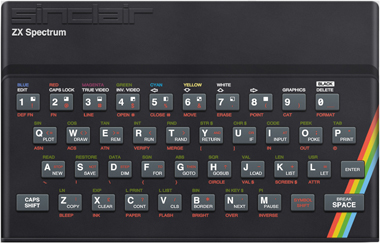 |
 |
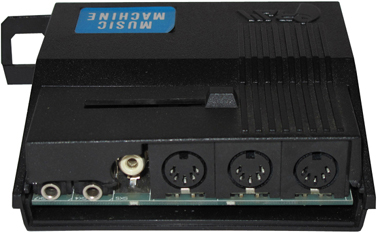 |
| the
sinclair zx spectrum with 48K RAM, with RAM music machine (£49.99)
attached. this powerhouse vintage computer music setup gave me 1.1
secs of 8 bit recording time at 19khz, up to 8 samples in memory at
once (duophonic sample playback) and also two midi notes could be
triggered from the MIDI out socket (on one channel only,
unfortunately). the phono socket was the main output, with mini mono
jack input for sampling and mini-jack headphone socket, besides MIDI
in, out, thru. |
||
| i sampled drums from
some of my favourite records (art of noise, depeche mode, sisters of
mercy, dalis car) and played these along with 2 notes (bass and pad)
from my casio ht700 keyboard: (£150, most of which i borrowed from my
mum) |
i played the spectrum sampled drums and keyboard sounds along with my
guitar playing for the track onto an old 70s tape deck i picked up
cheap. here is my 1989 quitar setup (including a truly hideous black
strat copy made of chipboard): |
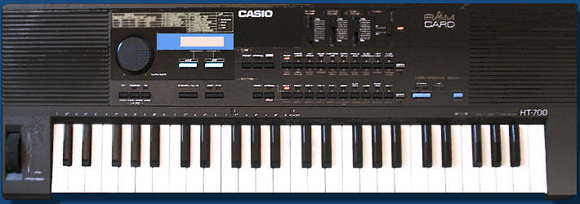 |
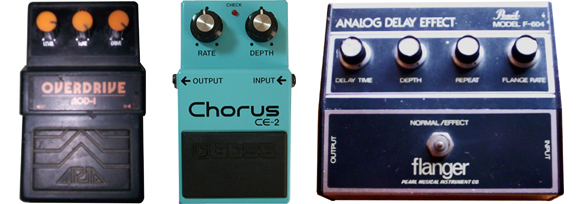 |
|
after recording the backing track of drums, synth and guitars onto one tape deck, (jvc top-loading), i then played it from that deck into a realistic reverb box and onto my second deck (trio front loading). - because the realistic box had a mic input i could sing over the top and actually have a more or less complete track. |
|
 |
|
 |
|
the deck i recorded the backing track on played very fast so i couldn't use it as the final master deck. it was by jvc, silver all over, i think this is the one. |
the realistic box was truly nasty - it had a juddery reverb sound, where you could hear the individual delays quite clearly, and was very noisy. |
this trio deck was the final stage, the motor was a little slow but that was OK, when anyone else played one of my tracks it would sound faster and more exciting. |
ok - what did this process sound like? hideous, i'm afraid, but i was very proud. i recorded a 4 track EP using this setup, which you can read about here. here is a sound example: song for clare when my mum heard this EP, she stopped worrying quite so much about me being a complete drop-out and began to think that i might have a career in music, so that's a bit of an accolade in itself. |
||
|
- - - - - - - - first album - 1990 - - - - - - - - |
||
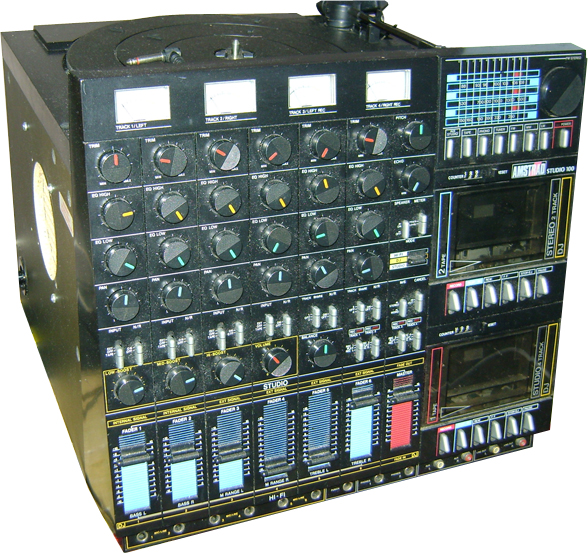 |
after the EP i carried on steadily (not quickly but steadily) writing tracks for my 1st album, using the tape decks, casio ht700 and realistic reverb box as detailed above. by this time i had dropped the spectrum setup as being too primitive and was using the drums on the keyboard instead, which had their own pattern sequencer. but i was getting frustrated. i really wanted a four track, for a start i wanted to get a bass guitar which would need its own track, but couldn't afford a proper one. then, in a local music store i saw this imposing beauty on the left for £125. i got it home and started to record some tracks with it. it was called the amstrad system 100, and it was a cheap midi hi-fi with 4 track recorder built in. in use however it was disappointing. the recording quality was very poor, loads of noise and unbelievable wow and flutter - i never heard anything oscillate like this. here is a sound example: a desperate defence the track above was recorded with a borrowed bass, not very good quality. eventually i found my own bass guitar, cheap but cheerful, in a local store for about £80.  this was by a company called franconia, never heard of by me before or since. the body was made of three pieces of solid wood glued together, a definite improvement on my chipboard guitar. here is a sound example of this bass recorded with the amstrad system 100: z. it is an improvement. |
|
| - - - - - - - - first album cont: 1991 - - - - - - - - | ||
by 1991 i had about 5 tracks of my 1st album recorded and wasn't really happy with the quality. the only thing to do was to get a proper 4 track by a dedicated manufacturer, but it was still beyond my means. eventually i persuaded my friend, with whom i had collaborated a few times, to go halves with me on a fostex 160 4 track, which cost £475 (actually, i think i paid £200 and he paid the rest) along with the fostex i bought more stuff over time, including an arbiter fuzz face and a boss rv-2 digital reverb to patch into the 4 track when mixing. i also managed to buy a yamaha qy10, which finally got me some slightly more impressive drum and synth sounds, as well as a more sophisticated 8 track sequencer. |
||
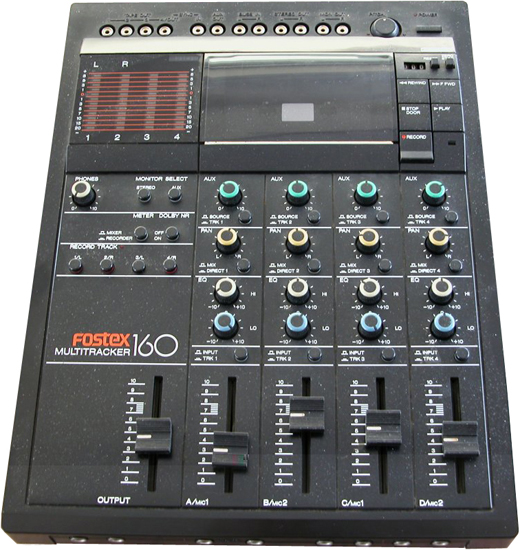 |
 |
 |
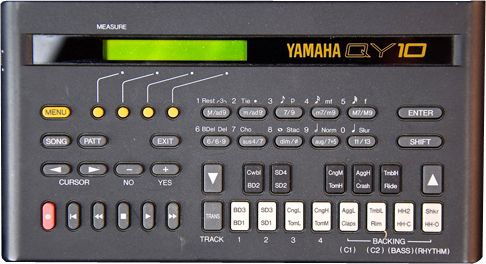 |
||
using all these extra bits of kit, particularly the fostex, i was able by the end of 1991 to finish my first album, using the name 'the value of suffering' and calling the album 'a connoisseur of personal anguish' - one of the year's most upbeat releases, as you can imagine. the recording quality was better than anything previously, but not as good as it could have been. the problem i had was, as a teenager in the mid 80s, we all had amps with bass and treble controls, and we usually turned them up to get what we perceived as a better sound. i unfortunately applied this principle to my recordings, boosting bass and treble not only when recording each track but also when mixing down. this resulted in a problem particularly with the high freqencies, which were noticeably harsh - at least to everyone else, but it was a while before i could hear it. sound example - this one includes the qy10 for drums and strings: how can you |
| - - - - - - - - second album: 1992 - - - - - - - - | |
having spent almost 3 years writing my first album, the second came a lot quicker. i met the young lady who became my wife in late 1991 (as a friend of a friend) and started to get to know her better in early 1992. not only did this result in a lot of lyrics, quite an outpouring in fact, it also resulted in a new musical direction. she had cable tv and watched mtv all the time, one of her favourite shows being 120 minutes which played all kinds of alternative and industrial tracks. when she played me some of the industrial stuff, it had an immediate impact and gave me the desire to sound more electronic. as a result, i connected my old casio up to the yamaha qy10 for some filtered lead sounds, and also started using the electronic drum sounds on the qy10 rather than the more natural sounds. i started to program drums in a more 'dance' style rather than the traditional rock patterns i had mostly created before. i used much the same recording setup for the 2nd album as the first, but with the addition of a couple of items. i got a red hondo 12 string guitar (made from plywood!), and a casio sk1 sampler keyboard (which only featured on the last track.) |
|
 |
 |
|
the 12 string was obviously much harder to play buy i managed to use it on some songs and really enjoyed the result. sound example: i know it's hard to love me (at 3:38 the 12 string starts) |
the sk1 was really just a toy but imparted an amazing characterful sound to whatever you recorded into it. it had 1.4 secs of sample time at about 9khz, and didn't keep the samples in memory, so i had to sample something, decide what to play with it, and get it recorded onto the four track all in one session, with little hope of ever retrieving the sounds created. it was worth it though. listen to this sound example: despite yourself (at 1:07 the sk1 comes in) |
my second album 'despite yourself' by the value of suffering was finished in early 1993 and i still think it has some great tracks. my guitar playing was also moving forward during this time, resulting in some great riffs (imho) unfortunately i still had the same problem with boosting bass and treble too high, resulting most noticeably in that same harsh top-end. it makes these tracks hard to listen to as a decent volume level. sound example: when your friends are ranged against you |
|
| - - - - - - - - third album: 1993 - 95 - - - - - - - - | |
|
after the rush of 1992, recording almost a whole album in a year, things slowed down again. i was writing at a slower pace and didn't acquire so many new bits of equipment. my wife and i married in march '95, and the third album was finished later that year. at the start in '93, i tried to carry on with the previous electronic style. because of the limits of the QY10 i was looking for a better source of synth sounds, and the first thing i tried was an atari st. |
|
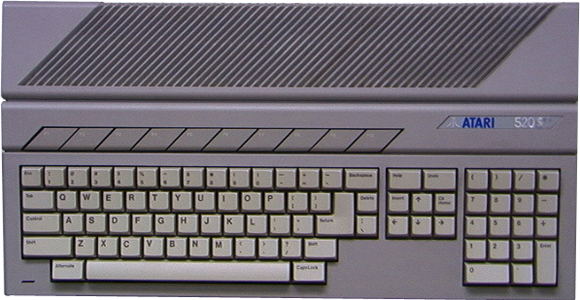 |
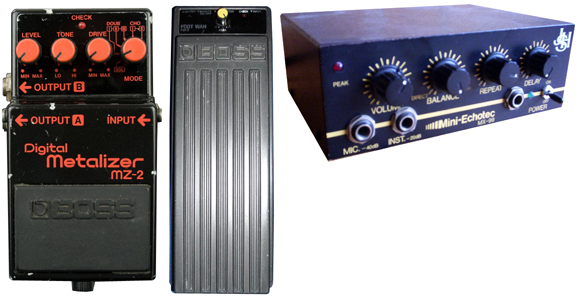 |
|
i started using the atari as a sequencer - this got around the 8 song limitation of the qy10's memory - also, the on-screen sequencing was obviously much easier. then, i looked into turning it into a sampler, buying first an 8 bit then a 16 bit sampler. sadly, neither of them worked out for me in terms of quality, so i got refunds and bought a yamaha tg-100 tone generator instead. i didn't like that either! it wasn't nearly as good as my friend's roland sound canvas. so i had to sell it in the end. |
also, my efforts at writing synth-based material were sounding a bit flat - i was uninspired. eventually, i took a riff i was working on with the tone generator and played it on the guitar instead, and much preferred it. i ended up buying stuff to reinforce the guitar sound and recording the whole album with guitars (and a bit of casio sk1) from left to right above: boss digital metallizer and wah pedal, and a jsh analog echo box, very atmospheric. |
thankfully, as far as recording as mixing went, i finally learned to set the bass and treble knobs both on 4 track and amplifier to the 'flat' position. this left behind the harsh treble sound of the 1st 2 albums to a large extent. i really liked all the songs on the 3rd album as well ('ugly industry' by the value of suffering), having felt that the last two weren't so consistent. one challenge, however, was trying to up the ante as far as sound design was concerned, but finding that my equipment was still limited and problematic, e.g. being plagued by cheap cables. still, i think this 3rd album was my best to date, have a listen to the sound examples below: ugly industry - ruined solitude - cool |
|
| - - - - - - - - fourth & fifth albums 1995-97 - - - - - - - - | |
|
while recording all the stuff above, i did loads of instrumental tracks as well as songs - these got collected to form my 4th album: 'by-product of society', made using all the equipment already documented. my fifth album was a bit of a departure from previous. i was going through a phase of writing hardly any lyrics, whilst ugrading equipment and having to learn new recording techniques as a consequence. the first thing i did was sell the st and buy an amiga 500, then a MIDI interface for it, and a copy of Octamed, pictured below right. it was time to track. |
|
 |
 |
as well as the MIDI interface i think i had to buy a sampler cartridge for the amiga. i also bought octamed, the famous 4 channel tracker with the vertical scrolling interface. i used to play bass drum, snare, bass sound and pad with the 4 channels, then program the hi-hats from the qy10 to save taking up 3 channels with drums. i remember that it was really easy to use create gated pad sounds, which i used often. |
i
didn't actually produce much music with the amiga, though i did have a
lot of fun with it. eventually when the time came it went down the rubbish chute in the block of flats we were living in (from 97 - 2000) because i couldn't sell it, although i sold the MIDI and sampling interfaces. here are a couple of (very grainy) sound examples of the amiga stuff: amiga 3 paul vi |
| in 1996, on holiday, i bought a
copy of future music mag that make a big impact on me. i read a review
of a new soundcard, called the yamaha sw60xg, which was basically the
guts of a £400 synth on a soundcard. it retailed for £150. i knew i had witnessed the birth of something different - having tried to make quality sounds with the spectrum, atari and amiga, finally good sound at a budget price was coming to home computers. during 1997, i managed to get enough parts together to make a 486 pc, which a friend assembled for me. he swapped me the motherboard and cpu (486 sx25) and the graphics card for a couple of my old guitar pedals, i bought 4MB of RAM for £20 per MB, a basic sound card to record with, a case for £20, and someone gave me an 80MB hdd. the pc had windows 3.1 installed. |
|
|
i couldn't afford the sw60xg yet, so to get started i bought this: |
|
 |
|
turtle beach 'maui' isa sound card, with memory slot at the back to insert simm - i think i had a 1MB simm and the 256k onboard memory, and later got a 4MB simm as well, for 5.25MB. most of the sounds i loaded were drum sounds, which i would then pass through the zoom 1010, to the right, as well as recording guitar and bass sounds via the zoom. i had to record all loops to tape before sampling into the pc, as the 486 sx25 cpu was not powerful enough to playback and record at the same time. annoyingly, despite being advertised as a 'sampling' card, the maui didn't record, so i had to continue using the cheap card. |
the zoom 1010, above, was a big change for me, having being used to stompboxes in the past. several fx in one box was really useful, especially being able to make presets with all fx and save them, then switch between them with the pedals. i also used the zoom to fx everything else, not just guitar and bass but also drums and synths. here is a sound example: loops recorded through the zoom to tape and played back from the maui: industrial1 |
| by late summer '97 i had managed to get an
sw60xg. my poor wife alone knows what we should have spent the money on. also, i managed to upgrade my cpu to a 486 sx2-50 (in paper for £5). |
with two sound cards
i needed a mixer: |
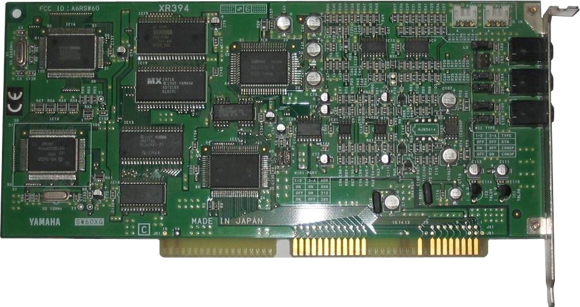 |
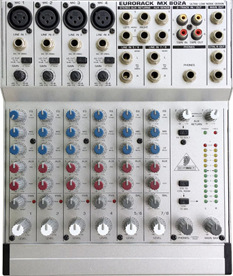 |
i combined the smoother synth sounds from the sw60xg with the distorted drums and guiars, sampled and played back wih the maui. sound example: industrial 2 (like the previous track but with bass pad from the sw60xg.) and here is a sound example of the sw60 by itself: synth4 |
the behringer mx802a gave me all the connections i needed and more for �125 - it was very quiet compared to other mixers i had seen and i was really chuffed with it. it's also the only piece of kit from this time period that is still in use. |
| this wierd time period of amiga experimentation and early pc system building left me with a disjointed collection of unfinished bits and bobs. i bunged the whole lot onto a cd and called it 'the bilgemeister' - it was a load of bilge. curiously this cd became my friend paul's (from my darling nihilist) favourite album of mine - he wants to make a film and use it as the soundtrack. strange. |
|
the 'bilgemeister' was the last value of suffering album - the hardware i used for harddisco albums continues here: harddisco early hardware |
|